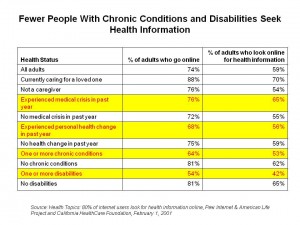 While 8 in 10 U.S. adult internet users seek health information online, they’re not the people you might assume would take advantage of the opportunity to do so. This lightbulb moment is brought to you by the Pew Internet & American Life Project’s latest survey analysis, Health Topics: 80% of internet users look for health information online.
While 8 in 10 U.S. adult internet users seek health information online, they’re not the people you might assume would take advantage of the opportunity to do so. This lightbulb moment is brought to you by the Pew Internet & American Life Project’s latest survey analysis, Health Topics: 80% of internet users look for health information online.
For example, while 2 in 3 U.S. adults with one or more chronic condition go online, only one-half of them are looking online for health information. Among the 54% of online adults with disabilities, only 42% of them seek health information online. Among the 88% of people online who are caregivers of loved ones, 70% look online for health information.
Susannah Fox of the Pew Internet & American Life Project calls this the “health information divide.”
Susannah has sliced and diced the Pew’s survey data from August-September 2010 of 3,001 adults. She’s mined the data to learn more about the online health information seeking population than any other published source. Here are some other gems from the analysis:
- 66% of internet users search for information on a specific disease or medical problem; however, many more females (74%) than males (57%) do so. In fact, more females seek all types of health information overall with the exception of environmental health hazards, where men have only a 1% point margin over women (23% vs. 22%, not statistically significant).
- More people with higher education levels also tend to seek health information online than people with less education, across all types of information seeking except for long-term care for an elderly person and information on pregnancy and childbirth.
- Some new categories were included in this survey that hadn’t been asked before; these include information on food safety and recalls, drug safety and recalls, pregnancy and childbirth, memory loss and Alzheimer’s, medical test results, chronic pain management, long-term care, and end-of-life decisions.
Health Populi’s Hot Points: As always when analyzing survey data, it’s instructive to look at the white space: that is, what’s not where you might expected a data point to be. For example, it is intriguing that health insurance info seeking has plateaued at around 1 in 3. I expect that this proportion will increase over next few years as newly-insured people will come into the system seeking information on health plans offered through health insurance exchanges (HIEs). As Medicare Part D saw an influx of seniors online seeking info on Rx drug plans 3 years ago at Medicare.gov and other sites, we’ll probably see uninsured people seeking info online to learn more about plan choices in their communities. This assumes, of course, that Congress won’t change that aspect of the Affordable Care Act. As people learn that information is freely available online to check on food safety and drug recalls, we should also see these percentages growing.
Susannah rightly calls out the “health information divide” between ill and well people, because that’s what it is. So much disease and disability is borne out of environmental and social factors such as air quality, availability of fresh healthy well-priced food, and quality of schools. Another major contributing factor of the health information divide is access to the internet and broadband: Pew has found that lack of access to the internet holds people “back from parity with people who report no chronic conditions.”
The FCC’s Broadband Plan recommendations focus on the importance of broadband in health. Once broadband breaches this divide, the needle will move on the proportion of people with disabilities and chronic conditions who lack internet access. That, then, bolsters health engagement and health outcomes.





 Grateful to Gregg Malkary for inviting me to join his podcast
Grateful to Gregg Malkary for inviting me to join his podcast  This conversation with Lynn Hanessian, chief strategist at Edelman, rings truer in today's context than on the day we recorded it. We're
This conversation with Lynn Hanessian, chief strategist at Edelman, rings truer in today's context than on the day we recorded it. We're